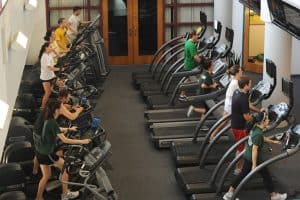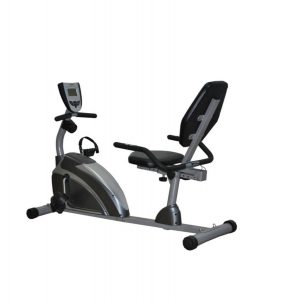Strangers often stop me to ask (usually with an English accent), “Excuse me good sir, but I must observe that you are a specimen of the human physique. How often do you visit a gym to maintain such a fine figure?”
Though that has never actually happened, if it did it would of course be flattering of these strangers to ask me such a thing. I would tell them so, but then have to shatter their illusion by informing them of the error in their assumption:
I have never worked out in a gym.

You might say it’s against my religion to join a gym (that is in fact how I frame my aversion to the places). I cannot ever recall setting foot inside of a gym, but I imagine them to be jungles of steel contraptions with distracting TV screens among which mobs of sweaty bodies share in one anothers’ stench and body heat. This is, incidentally, also my perception of sports bars and night clubs, which I also habitually avoid.
Despite my disdain for fitness clubs and their ilk, I am a big believer in the value of regular exercise to achieve physical fitness. I just do not believe that gym memberships are needed to achieve physical fitness, nor are they a good value proposition. $30-$50 per month for the privilege of essentially renting shared, generally unnecessary equipment is a poor return on investment. There is the time consideration too: it is enough of a task to get one’s self motivated to workout in the first place, without adding the effort of having to leave the house, drive across town, and presumably share a shower with gym rats afterwards. Who has time for such catfacery?
It is truly a better value to exercise at home:
- The barriers between motivation to execution are dramatically reduced.
- You don’t need expensive equipment (or renting use of such).
- You can reduce the probability of having to interact with a gym rat. That is never a bad thing.
If it seems overwhelming to figure out an effective workout regimen without the benefit of gym equipment or a personal trainer (more waste of money), then allow me, for the moment, to serve in that guiding role by providing you with an example of what I have found works for me.
My Simple Exercise Regimen
The most important thing to remember where fitness is concerned is that the best exercise routine is the one you will actually do. I believe in keeping things simple with the best Return On Investment (ROI). Meaning: the most effective workout for the least amount of time and expense.
From studying innumerable articles on the subject (with much credit due to the fantastic Dr. Mercola), I have pieced together an exercise regimen which aims to provide the best ROI. I am always fine-tuning the plan as I discover new information, but this is what currently works for me:
- Everyday lifestyle behavior
- 7 days per week — stretching exercises
- 1-2 days per week — High Intensity Interval Training (HIIT)
- 1-2 days per week — bodyweight strength training, using “Super Slow” technique
Everyday lifestyle and behavioral changes.
Don’t underestimate the cumulative effect of little changes. This includes such basics as taking the stairs instead of elevators, parking your car on the far end of the parking lot instead of near the door, and using your body instead of machinery for basic everyday tasks (such as shoveling snow instead of using a snow blower, hoeing the garden instead of reaching for the row-tiller, digging holes by hand instead of using equipment).
This is by no means revelatory stuff, but I think we often choose convenience over fitness.

As a recent example, I am personally amazed at what an effective full-body workout it is to dig a hole by hand! After I hand-dug a 6′ x 5′ x 6.5′ hole this past Summer to install an egress window on our house, I have renewed respect for old-time grave diggers (and maybe their less illustrious counterparts, grave robbers).
Sit as little as possible. We all sit too much, and our bodies were just not meant to be seated so often. If you must sit (such as traveling or at the office), aim to get up and walk around for five minutes every hour, and avoid sitting for more than an hour at a time.
There is a lot of research which points to the dangers of sitting. Here is a video which summarizes nicely:
Stretching Exercises — 7 days per week
You should of course stretch before and especially after every workout in order to maximize the effectiveness and minimize injury. Even on rest days where you do not work out, however, there are many benefits to stretching, such as increasing flexibility and minimizing risk of injury.
Dedicate five minutes per day to stretching each of your main muscle groups for approximately 30 seconds per muscle. Mayo Clinic has an excellent slideshow guide to show you how to safely and effectively do this: Mayo Clinic’s Guide to Basic Stretches.
High Intensity Interval Training — 1 to 2 days per week
Don’t let the term scare you; there is nothing especially remarkable about HIIT except the effectiveness. Athletes have long known the benefits of mixing up their cardio workout with spans of intensive speed, done in short intervals. A 20 minute HIIT workout has shown benefits which would take more than 90 minutes at a steady pace.
A 20 minute HIIT routine is simple:
- Begin with a three minute warmup, pedaling (or walking) at a casual pace.
- Then, after three minutes do eight repetitions of the following:
- Pedal as fast as you can for 30 seconds.
- Return to your casual pace for 90 seconds.
- After doing eight reps, cool down at a casual pace for about one minute.

While you can certainly interval train by walking and running, the best way to do HIIT is on a recumbent bike. A recumbent bike is not the sexiest piece of exercise equipment, but it has many benefits such as eliminating impact to your knees and joints when compared to running or even an upright bike. It is also much easier on your back versus the unnatural slouched position that a standard upright bike forces you into holding.
The recumbent bike RaeLea and I own is the Exerpeutic 900XL. This is the one we purchased (actually three of them so far: one for at our workplace, one for home, and one we gave as a gift). This one has good overall reviews, a 300 pound capacity, is lightweight and very affordable at less than $170.
Bodyweight Strength Training — 1 to 2 days per week
“Bodyweight” just means exercising using your own body weight in lieu of a weight set. You can integrate resistance bands to increase the workout intensity if you feel the need, though I don’t usually do so.
Strength training has been proven time and again to effectively burn fat, and no, it does not necessarily mean that you will “bulk up” by doing so (just look at my own girlish figure as an example!). Dr. Mercola unsurprisingly covers strength training basics in great detail, if you are interested in learning more.
The most important method of maximizing the effectiveness of your strength training exercise is to use the “Super Slow Technique.” I like Dr. Mercola’s version of the technique:
- Begin by lifting the weight as slowly and gradually as you can. Dr. Mercola suggests doing this with a four-second positive and a four-second negative, meaning it takes four seconds, or a slow count to four, to bring the weight up, and another four seconds to lower it. (When pushing, stop about 10 to 15 degrees before your limb is fully straightened; smoothly reverse direction)
- Slowly lower the weight back down to the slow count of four
- Repeat until exhaustion, which should be around four to eight reps. Once you reach exhaustion, don’t try to heave or jerk the weight to get one last repetition in. Instead, just keep trying to produce the movement, even if it’s not “going” anywhere, for another five seconds or so. If you’re using the appropriate amount of weight or resistance, you’ll be able to perform four to eight reps
- Immediately switch to the next exercise for the next target muscle group, and repeat the first three steps
You can figure out the types of strength-training exercises which work best for you, but for simplicity’s sake, I have found that these work well for me:
- Yoga Planks (2 to 3 times per day, aiming for 2 minutes each time. These are nice because they require minimal movement but are great for working core muscles and lower back)
- Squats (excellent for working compound muscle groups and balance)
- Push-ups
- Pull-ups (or “chin ups”)
…all of course using the “Super Slow Technique” to maximize the workout and reduce the amount of time spent working out.
The misguided concept of “No pain, no gain”
Whenever exercising, remember to listen to your body. That old adage “no pain no gain” is just plain foolish. Sore muscles are good, but a painful back or knees is your body’s way of telling you that something is wrong. If your body is in pain after working out, you are doing something incorrectly and you need to reevaluate. Often that means stretching more effectively before and after your workouts, hydrating more, and improving your overall form.
And remember: if you want to go back to the basics, you can just grab a shovel and start digging a hole!
